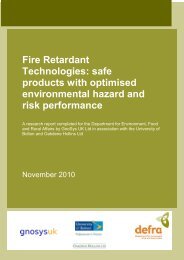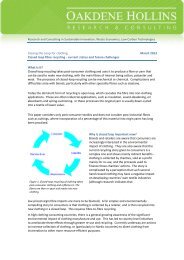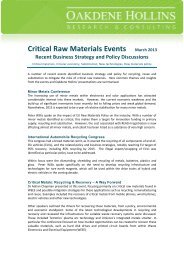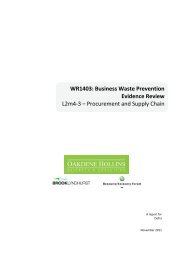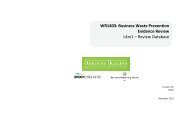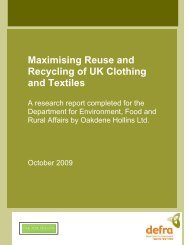Recycling of Low Grade Clothing Waste - Oakdene Hollins
Recycling of Low Grade Clothing Waste - Oakdene Hollins
Recycling of Low Grade Clothing Waste - Oakdene Hollins
Create successful ePaper yourself
Turn your PDF publications into a flip-book with our unique Google optimized e-Paper software.
© <strong>Oakdene</strong> <strong>Hollins</strong> Ltd, Salvation Army Trading Company Ltd<br />
Nonwovens Innovation & Research Institute Ltd September 2006<br />
was started in 2000 and recently extended its premises to 10,000 square feet<br />
and continues to grow and develop. With facilities for Light Resin Transfer<br />
Moulding (Light RTM) and CNC machining the company are equipped to<br />
take projects from conceptual design, through pattern and mould making to<br />
component manufacture. Typical applications for low‐modulus composites<br />
include:<br />
• Telephone hoods, kiosks and shelf mouldings<br />
• GRP covers & guards<br />
• Composite housings, e.g. for telephone exchange, general storage and<br />
lock boxes.<br />
We developed initial concept samples using nonwoven technology to<br />
produce pre‐form textile reinforcements for a range <strong>of</strong> thermoset resins<br />
such as polyester and epoxy. These pre‐form architectures were then<br />
impregnated with epoxy resin and bioresin (from rapeseed oil) to produce<br />
comparatively low‐modulus composites structures. It was decided to use<br />
this approach when designing structures for low modulus applications.<br />
12.2.2 Experimental Work<br />
Developing the concept from the original sample, the general requirements<br />
for a substrate for reinforcing a LRTM composite panel were described as:<br />
• Lightweight<br />
• Must provide stiffness to the final part<br />
• Must allow resin to flow through the sample whist being compressed<br />
under a vacuum<br />
• Must have a degree <strong>of</strong> conformability.<br />
Based on these criteria a nonwoven architecture with a proportion <strong>of</strong> fibres<br />
periodically oriented in the Z‐direction (through the fabric plane linking the<br />
top face to the bottom face) was produced. This fabric resisted total<br />
compression <strong>of</strong> the structure under vacuum. The most appropriate<br />
nonwovens technology was dry‐laid needle‐punching. It was decided that<br />
the fibre selection, based on the criteria above, must include a proportion <strong>of</strong><br />
glass as well as recycled textile to provide adequate stiffness properties and<br />
therefore, the fibre blend was as follows:<br />
56.6% Glass fibre<br />
26.7% Recycled Acrylic fibre (Salvation Army Trading Company)<br />
16.7% Bicomponent Polyester/Co‐polyester<br />
The fibres were mechanically blended and carded to produce a coherent<br />
cross‐laid web. The web was subsequently needle‐punched using the<br />
conditions shown in Table 22.<br />
For Defra Page 104



